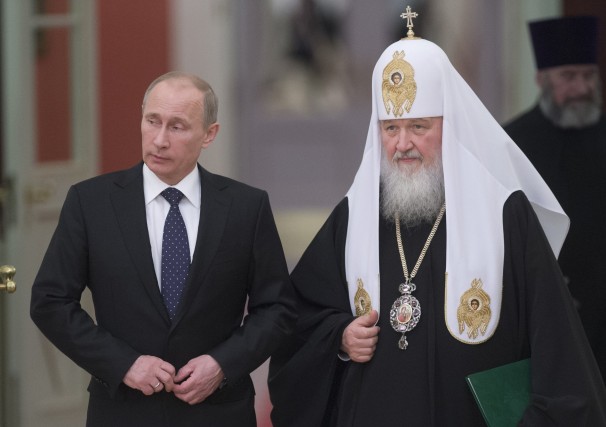
History Of Russia
Don’t underestimate importance of religion for understanding Russia’s actions in Crimea.
Russia’s President Vladimir Putin and Patriarch of Moscow and All Russia Kirill arrive for the meeting with Russian Orthodox church bishops in Moscow on Feb. 1, 2013. (Sergei Gunyeev/Reuters)
The following is a guest post by Mara Kozelsky, a historian at the University of South Alabama who studies Crimea in the Russian Empire. Here she discusses the importance of Crimea for Russia’s religious identity, the focus of her book, “Christianizing Crimea: Shaping Sacred Spaces in the Russian Empire and Beyond” (Northern Illinois University Press, 2010).
******
As analysts debate Russia’s interests in Crimea, they must not underestimate the role of religion. Orthodox Christian nationalism has been on the rise in Russia from the collapse of the Soviet Union. The close relationship between Russian church and state is everywhere evident, from the persistent refusal to allow the pope onto Russian soil, the ejection of the Salvation Army from Moscow in 2001 and the subsequent restrictions placed on Protestant missions. Patriarch Kirill has inserted himself more visibly in Russian politics than his predecessor, Patriarch Aleksei. The prosecution of Pussy Riot for performing in an Orthodox church as well as dismaying anti-homosexual legislation reflects a new stage in the evolution of Russia’s deeply conservative Orthodox identity. As the so-called “Cradle of Russian Christianity,” Crimea fits into this trajectory too.
Theocratic notions of Russian identity date to the Byzantine theory of Symphonia, in which the church and the state should ideally function as distinct but harmonious entities. Early Russian Tsars who portrayed themselves as divine right rulers, and Russian state theorists promoted Moscow as the Third Rome. After the fall of Rome to Visigoths and then Byzantium to the Ottomans, it was left up to Russia, according to this idea, to preserve the one true faith. As Western governments separated church from state, Russia moved in the other direction. Nicholas I (1825-1855), the Tsar famous for suppressing the Hungarian Revolution and fighting the Crimean War, summarized Russia’s church-state identity in the phrase “Orthodoxy, Autocracy, Nationality.” This trinity became the guiding concept of Russian national identity through the Russian Revolution of 1917.
Crimea sits at the heart of both the Third Rome idea and Nicholas I’s nationality platform, because it was on the peninsula that Byzantium passed the mantle of Orthodoxy to Russia. In the ancient Greek colonial city of Chersonesos, the Byzantine emperor baptized the Kyivan Rus Prince Vladimir. Prince Vladimir’s conversion has been described by an early Russian nationalist as “the most important event in the history of all Russian lands,” because the conversion “began a new period of our existence in every respect: our enlightenment, customs, judiciary and building of our nation, our religious faith and our morality.”
Beyond Prince Vladimir’s conversion, Crimea gave Russia a first century Christian pedigree. Roman Emperor Trajan exiled the first century pope Clement to Crimea, where he founded an early Christian community that hid among neolithic caves. Some biblical scholars also believe St. Andrew the Apostle passed through Crimea en route to his mission field in Scythia. Until the communists imposed an official policy of atheism, Russian archaeologists, historians and biblical scholars combed over the peninsula looking for the exact location of Prince Vladimir’s conversion and evidence supporting the first century legends. The Russian Orthodox Church, meanwhile, established a network of monasteries on the peninsula and promoted pilgrimages to “Russian or Crimean Athos.” Crimea became Russia’s very own holy place.
The revival of religion following the Soviet collapse brought Crimea once again into the Russian spiritual orbit. From the 1990s, the Russian Orthodox Church in Ukraine (UOC-MP) competed successfully with other branches of the Ukrainian Orthodox Churches to restore Crimean Christian holy places. The Russian church ignored protests of Muslim Crimean Tatars to install crosses in major population points. Russian monks took residence in newly renovated monasteries and Russian pilgrims poured in through guided tours. At the center of the controversy, the Russian Orthodox Church began building a church on top of the ruins of Chersonesos without the consent of the museum preserve or the Ukrainian government. It also hired a helicopter to airlift a gazebo to mark the baptismal font of St. Vladimir on the ruins (see photo below). Four years later, President Vladimir Putin joined then-Ukrainian President Leonid Kuchma as the Russian Orthodox cross was raised over the completed church on the ruins of Chersonesos.

BY MARA KOZELSKY March 13 at 3:29 PM